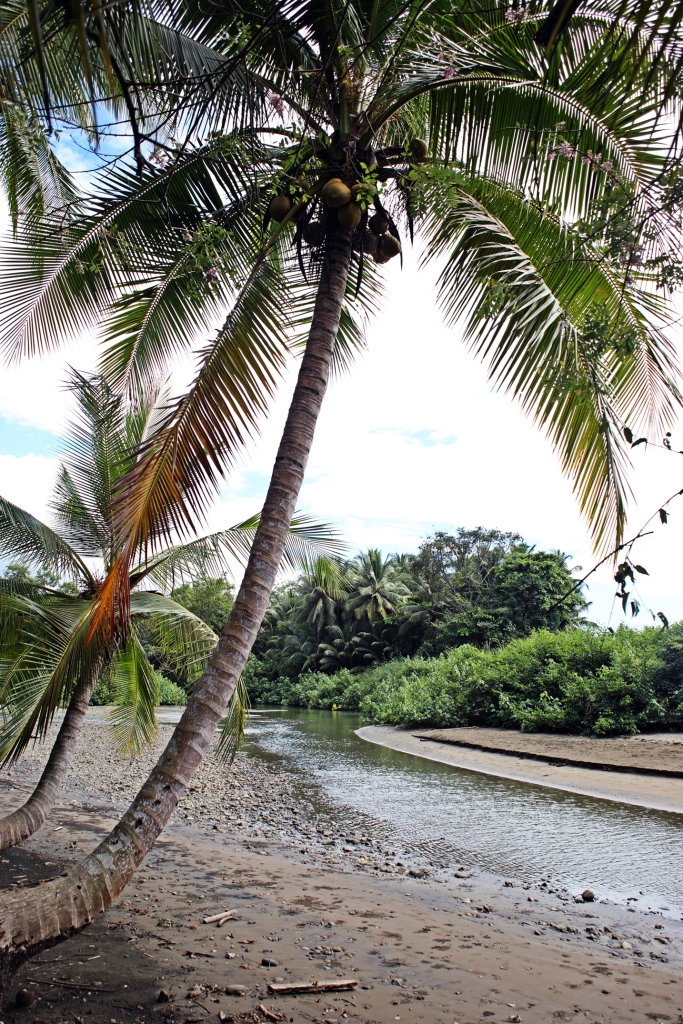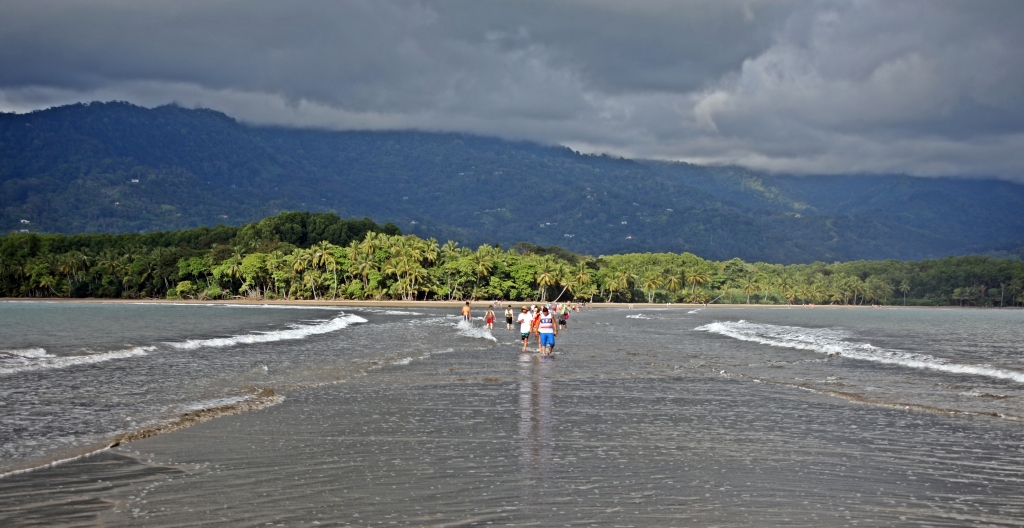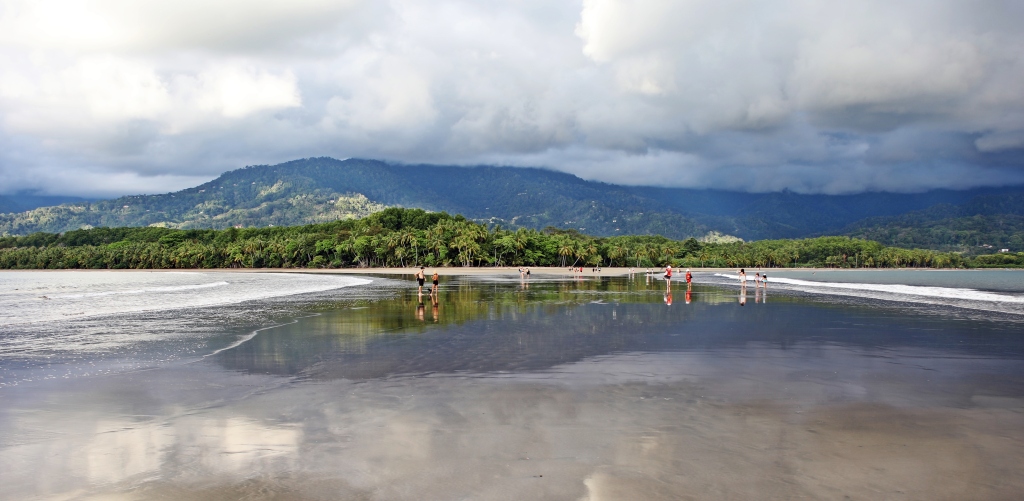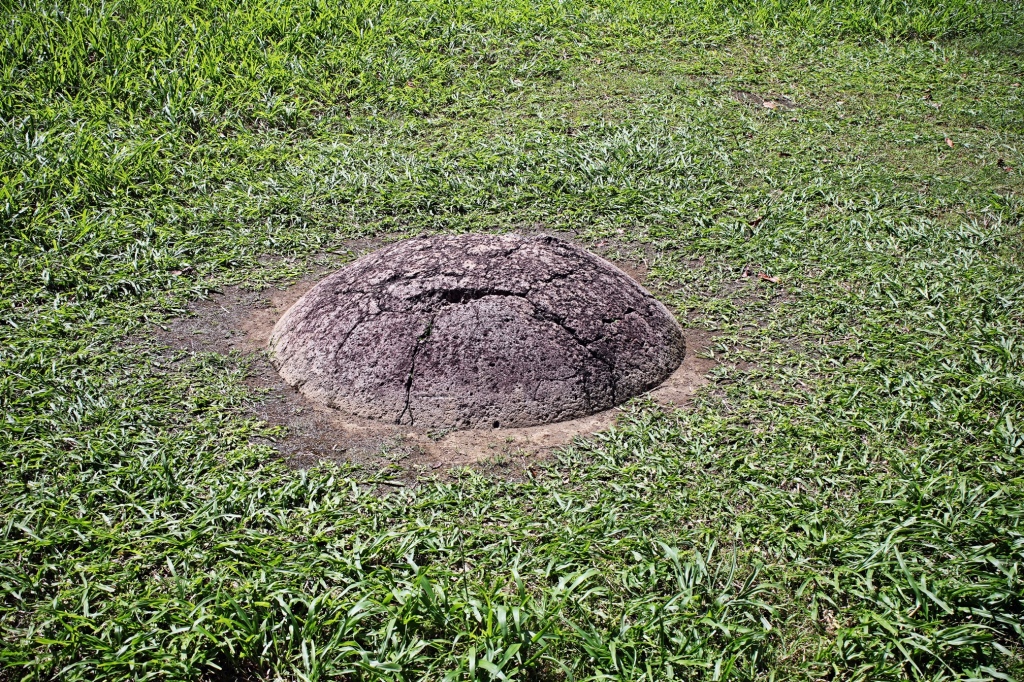There’s a unique feature on Costa Rica’s southern coast that only exposes itself during low tide. A long sandbar joins to a rocky point over a kilometer away to make the form of a whale’s tail.
Ballena National Marine Park
Southern Costa Rica’s Ballena National Marine Park (Parque Nacional Marino Ballena) is a wonderful spot along the Pacific coast. Most of the park is in the ocean, but on the edge is a 3 ½ km long beach that includes the beaches Uvita and Colonia. We walked most of the length of the beach and saw a flock of red macaws, a coracora and skittish shorebirds running at the water’s edge. The sand on the beach is not the nicest since its quite muddy, but the scenery is spectacular with the palm trees lining the edge. You can only access these beaches after paying at the park entrance gates so they are relatively quiet.

Uvita Beach, Ballena National Marine Park 
Estuary, Ballena National Marine Park 
Palms, Ballena National Marine Park 
Washed up buoy, Ballena National Marine Park 
Uvita Beach, Ballena National Marine Park 
Shorebirds, Ballena National Marine Park 
Caracara, Ballena National Marine Park 
Esturay, Uvita Beach, Ballena National Marine Park 
Lifeguards, Uvita Beach
The area was designated as a national park to protect Humpback Whales that migrate to this area from the north and south at different times of year. We didn’t go whale watching, but there’s another whale feature in the park that we wanted to see. A naturally occurring whale’s tail image is formed by ocean currents and becomes exposed during low tide.
Uvita Point is a formation of rocks over 1 km offshore from Uvita Beach. During high tide, you can barely see the tips of these rocks. As the tide begins to recede, ocean waves come around the sides of Uvita Point and crash into each other from both sides. These waves and their currents have formed a fascinating sandbar. As the tide recedes more, the waves form interesting geometric patterns from their opposing forces. It was so much fun walking out to Uvita Point as the tide was going out and a sandbar was emerging with every step. Waves were coming in at us from both side of the sandbar and meeting in the middle forming interesting zig-zag patterns. When the tide is at its lowest, a completely exposed spit joins the mainland to Uvita Point’s rocky island over 1 km away.
The pictures below show a chronology of the receding tide and the appearance of a sand bar. You can’t see the whale tail image from the beach so we’ve included an aerial picture from the web. During high tide, the aerial shot would look like a normal beach.

Walking toward Uvita Point with waves on both sides of Whale Tail sandbar 
Zig-zag pattern created by opposing waves, Ballena National Marine Park 
Looking toward Uvita Beach with receding tide on Whale Tail sandbar 
Walking toward Uvita Point in low tide on Whale Tail 
Walking toward Uvita Beach in low tide on Whale Tail 
Low tide on Whale Tail sandbar, Ballena National Marine Park

We have since read that the 2011 tsunami that hit Japan also caused damage to the whale tail spit. The power of Mother Nature however, meant that just one month later it was back to near normal.
Click for information on Ballena National Park
Finca 6 Archeological Museum
Fifty kilometers south of Uvita is one of a only a few archaeological museums in Costa Rica. There are mysterious large stone orbs spread across south western Costa Rica. Archaeologists don’t know much about these giant stone spheres or the people who created them. The stones were crafted into spheres between 200 BC to 1500 AD. It’s believed they were for astronomical or religious purposes or to demonstrate the wealth and power of the chief. They range in size from a few cm to almost 2 m in diameter. Researchers believe they know the tools and methods that were used to make them, but the rest is still a mystery.
The spheres were only discovered in the 1930s when the area was being cultivated for banana plantations. Many of them were damaged by bulldozers and machinery. One farming area, Finca 6, had a high proportion of the spheres and a few that were undisturbed. Finca translates to farm in English, and Finca 6 Archeological Museum, is located in what used to be a banana plantation.
We were curious to see these strange stone artifacts, but unfortunately the museum was a huge disappointment. There were only 2 dozen or so spheres on the museum grounds. Some are partially buried, others are above ground. We expected more from the museum and in fact on the drive back we saw at least a dozen scattered throughout a small park and on people’s lawns in the town of Palmar Sur. If you really want to see these artifacts we suggest walking through Palmar Sur for free rather than spending $12 USD to visit the disappointing museum.

Partially buried stone spheres, Finca 6 
Partially buried stone sphere, Finca 6 
Stone spheres, Finca 6 
Stone spheres, Finca 6
Visiting Marino Ballena National Park
Entrance Fee – $7 USD each and you can go in and out multiple times per day. When we were there it was free after 4pm.
Note: Remember to check the times for low tide.
Getting to Marino Ballena National Park
By car – The closest town to the park is Uvita which is located on the Costanera Sur Highway. There is a parking lot at the Uvita Beach entrance.
By bus – Public buses run up and down the Costanera Sur highway allowing you to get to or from any of the neighboring cities. They only run a few times a day though and are not usually air-conditioned. Tracopa has air-conditioned buses that travel through Uvita on their way to or from San Jose. They may charge you the full fare though, no matter where you get on or off.
By Air – The closest airport is in Quepos, 67 km north.
www.centrocoasting.com is a great resource for bus schedules in Costa Rica.
Where to stay
The closest town is Uvita. There are quite a few hotels and restaurants near the Costanera Sur highway. From there you can walk 30 minutes, or take a taxi to the park entrance. There are also backpacker hostels near the park entrance. We stayed in Uvita and loved seeing local homes surrounded by lush, tropical gardens.

Lush trees in Uvita town
Getting to Finca 6 Museum
By car – The Museum is located between small towns of Palmar Norte and Sierpe just off Hwy 223. If you have a car you could easily visit on a day trip from Uvita.
By public bus – Get off at Palmar Norte located on the Costanera Sur Highway. Finca 6 is 10 km south along Hwy 223. There are a few pubic buses traveling from Palmar Norte toward Sierpe, but you will have a couple of hours to wait for the return bus back to Palmar Norte.
Coming Next: A Costa Rican Jungle Safari in Manuel Antonio National Park
To read about more of our adventures go to Destinations.
For extra pictures from Costa Rica click here. For pictures from our other blogs go to Gallery at monkeystale.ca
If you like what you read, please comment or share (with credit) using the links below.
Nothing as good as almost having the beach to yourself. Were these stone spheres naturally occurring or man made? They remind me a bit of the Moeraki Boulders in New Zealand. Thanks for sharing. Allan
LikeLiked by 3 people
They were man-made. Sorry maybe I should explain that better in the post. I haven’t seen the ones in New Zealand, I’ll have to look on-line. Thanks Allan! Maggie
LikeLiked by 1 person
Ballena National Marine Park sounds like a my kind of place. I would love to see green marine iguanas, not to mention humpback wales! Costa Rica has some of the most beautiful beaches and palm trees. Thanks for sharing and have a good day. Aiva
LikeLiked by 4 people
Thanks Aiva, the scenery in Costa Rica is incredible! They have more beaches than you could visit in a lifetime! Thanks for reading. Maggie
LikeLike
That’s a whale of a tale!
LikeLiked by 3 people
Hahaha 😊😊
LikeLiked by 1 person
Very well done! I like the way this post is sectioned out. Clear, informative, and easy to read. I was with my family in Costa Rica years ago. We started at Arenal Volcano and made our way down to Manuel Antonio where we crossed the Rio Tarcoles Bridge and observed the crocodiles below. Looking forward to your next post on Manuel.
LikeLiked by 3 people
Thank you very much Roxane, I really appreciate the feedback. Maggie
LikeLike
Beautiful captures! Love to visit this park in the near future.
LikeLiked by 2 people
Thank you Amy, Costa Rica has so many beautiful places.
LikeLiked by 1 person
Wow, that marine park really looks stunning. I said in my last comment that I’m not really a beach person. Maybe you are converting me!
LikeLiked by 2 people
It makes a difference when they are pristine beaches without having to share! 😊
LikeLike
So looking forward to exploring Costa Rica – thanks for your insights because it looks amazing..
LikeLiked by 2 people
Your photos of Ballena National Park remind me a lot of what we saw in Corcovado National Park. I loved the beautiful coastline but I think my most vivid memories are of all the colourful, tropical birds. I wish we had seen the stone spheres…I’d never heard of them before your post.
LikeLiked by 1 person
Corcovado isn’t far from Ballena so probably similar coastline. I couldn’t believe it when we saw a flock of red macaws! And toucans! The stone spheres were interesting but not enough for a special trip to the area. You probably saw some on people’s lawns around Corcovado but didn’t know what they were.
LikeLiked by 1 person
I could have spent our entire time in Corcovado sitting on our bungalow’s balcony watching the macaws and toucans.
LikeLiked by 1 person
Incredible pictures. The natural phenomenon of whale’s tail image is fascinating. Looks like you had a great time!
LikeLiked by 2 people
Thank you, we actually enjoyed seeing the whale tale emerge a lot more than we expected. It’s such an unusual, natural feature. Thanks for reading! Maggie
LikeLike